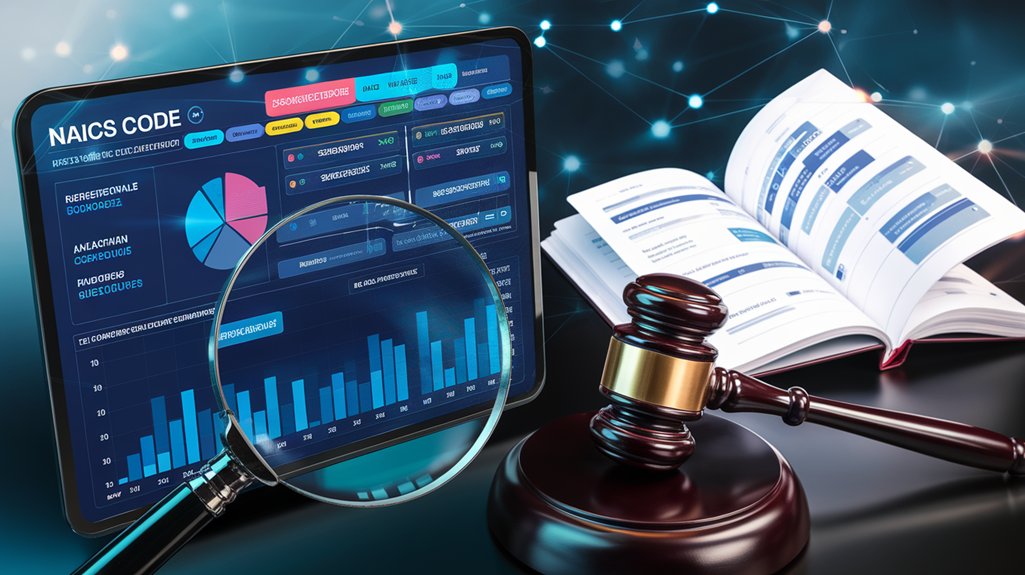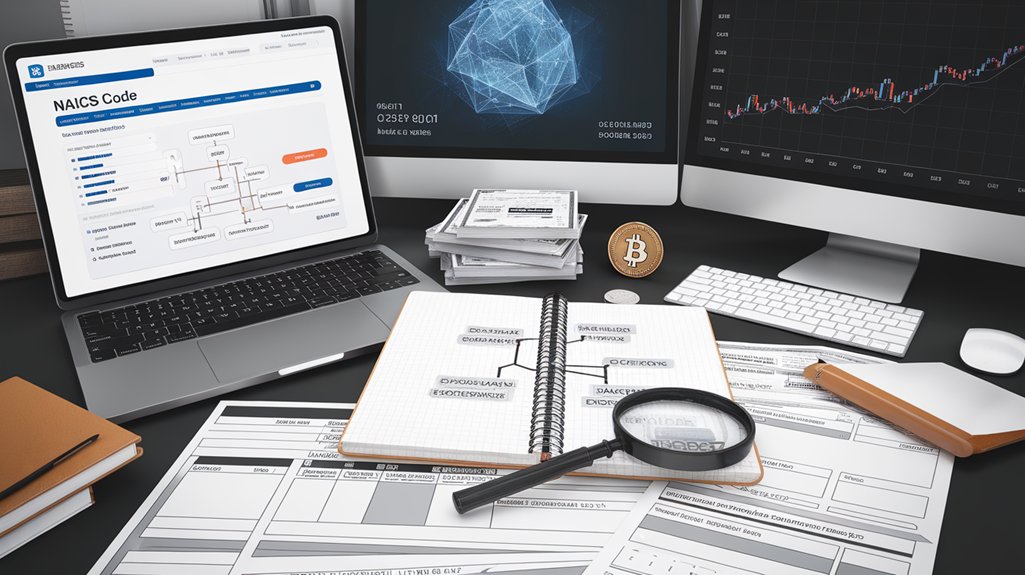To identify the perfect NAICS code for SAM registration, analyze your primary revenue sources and core business operations. Use the Census Bureau’s NAICS search tool with relevant keywords, then compare your activities against detailed descriptions. Select 3-5 codes that accurately represent genuine capabilities, not aspirational services. Document your selection process for future reference, and regularly review codes as your business evolves. Strategic NAICS code selection enhances visibility and qualification for a broader range of federal contracts.
Understanding NAICS Codes and Their Impact on Federal Contracting

When businesses seek to compete for federal contracts, they must navigate the North American Industry Classification System (NAICS), a standardized framework that categorizes companies based on their primary business activities.
This NAICS classification system, developed collaboratively by the US, Canada, and Mexico, uses a hierarchical 6-digit code structure that progresses from broad sectors to specific industries.
Federal contracting officers must assign a single NAICS code to each solicitation based on the contract’s principal purpose, as mandated by FAR 19.102.
This code assignment directly determines size standards that establish whether a company qualifies as a small business for that opportunity.
SBA regulations in 13 CFR 121.402 govern this process, ensuring proper solicitation alignment with the actual work required.
Compliance implications for businesses include potential bid protests, loss of contract eligibility, and audit risks if codes don’t accurately reflect their industry sectors or competitive bidding category. Selecting the correct NAICS codes is essential for streamlining the government procurement process and enhancing your competitiveness in securing contracts. Businesses should ensure they select the appropriate codes during SAM registration, as this affects eligibility for small business set-asides and specialized contracting programs. The UEI number obtained through SAM.gov is also required for all businesses seeking to participate in government contracting opportunities.
Step-by-Step Process for Finding Your Primary NAICS Code

Finding your primary NAICS code involves a methodical approach that businesses must follow to confirm accurate industry classification. The process begins with analyzing your company’s primary revenue sources and core operations to determine where your business fits within the NAICS classification system.
First, identify which business activity generates the majority of your revenue. Next, visit the Census Bureau’s official NAICS search tool and enter relevant keywords describing your products or services. Review the resulting codes at each hierarchical level, from sector (2-digit) down to national industry (6-digit).
Determine your revenue drivers, then search the Census Bureau’s NAICS database to find your appropriate classification level.
Compare your operations against the detailed descriptions for each potential code. When evaluating options, consider:
- Where most employees dedicate their time
- Your primary establishment purpose
- How similar businesses are classified
Your chosen NAICS code will ultimately help determine if your company qualifies as a small business for government contracting opportunities. Remember that the Census Bureau assigns one NAICS code per establishment based on the primary activity generating the most revenue. Selecting a code that accurately represents your core activities is essential for improving visibility in government contracting. After selecting a code, validate it against SAM.gov requirements to confirm compliance with federal contracting standards. Document your selection process for future reference during registration.
Strategic Selection: Maximizing Opportunities Through Multiple NAICS Codes

Although businesses typically identify a primary NAICS code, strategic selection of multiple codes often creates significant competitive advantages in government contracting.
Businesses can enhance visibility in SAM.gov searches, qualify for a broader range of federal contracts, and position themselves for business growth across various sectors.
When selecting multiple NAICS codes, companies should:
- Choose codes that accurately reflect current capabilities
- Limit selection to 3-5 codes to maintain credibility
- Review and update codes regularly as services evolve
This approach provides operational flexibility, allowing businesses to pivot toward new opportunities when market conditions change. Accurate NAICS code determination ensures businesses are properly classified and eligible for relevant government contracts and assistance programs.
Companies with diverse classifications demonstrate versatility to federal agencies while maintaining focus on core competencies.
The competitive advantage comes not from quantity but from strategic alignment—each code should represent genuine expertise rather than aspirational services, ensuring businesses appear in relevant searches for contracts they can genuinely fulfill.
Understanding the industry sectors most frequently engaged in government contracting can help companies identify relevant NAICS codes that align with their capabilities.
Federal contracting trends should be monitored closely to adjust codes according to evolving agency needs and priorities.
Frequently Asked Questions
Can Changing My NAICS Code Affect Existing Contract Relationships?
Changing NAICS codes can impact existing contract relationships in several ways.
While ongoing contractual obligations typically remain valid, the business may face challenges with contract renewals if their new classification no longer aligns with project requirements. This misalignment could affect their business reputation among government agencies and partners.
Additionally, procurement systems may flag discrepancies between the contract’s NAICS designation and the company’s updated profile, potentially requiring administrative adjustments to maintain compliance with regulatory standards.
How Often Do NAICS Codes Change for Emerging Technologies?
NAICS codes are formally updated every five years to accommodate emerging technologies. The most recent update occurred in 2022, with the next revision scheduled for 2027.
These updates typically include new classifications for innovative sectors, particularly in Information Technology (NAICS 51) and IT Services (NAICS 541).
The Office of Management and Budget solicits public comments during each revision cycle, allowing industry input on necessary changes to capture technological advancements and economic shifts in the classification system.
Do International Businesses Use Different Classification Codes With SAM?
International businesses use the same NAICS codes as domestic entities when registering in SAM, maintaining global standards across borders.
However, these international companies face additional requirements, including obtaining an NCAGE code and providing ISO 3166 country codes for their location and incorporation.
While the classification system remains consistent with domestic businesses, international entities must navigate both NAICS requirements and their local international regulations when completing their SAM registration process.
What Happens if Competitors Challenge My NAICS Code Selection?
When competitors challenge a company’s NAICS code selection, the matter goes before the SBA’s Office of Hearings and Appeals (OHA).
Competitor objections must be filed within 10 days of solicitation issuance. OHA reviews the work description against official NAICS definitions to determine code accuracy.
If successful, the challenge can change the applicable size standard, potentially disqualifying previously eligible businesses.
Companies should maintain documentation supporting their code selections and consider registering multiple codes that accurately reflect their capabilities.
Can Selecting Certain NAICS Codes Trigger Additional Compliance Requirements?
Yes, certain NAICS codes can trigger additional compliance requirements with significant regulatory impact.
Industries like healthcare, defense, and environmental services often face stricter oversight. For example, construction NAICS codes (236-238) require adherence to specific OSHA standards, while food production codes (311) necessitate FDA compliance.
The compliance implications vary by industry, potentially including specialized certifications, security clearances, environmental reporting, or industry-specific regulations that businesses must satisfy to maintain eligibility for government contracts.